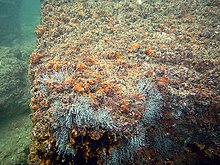Perifiton

Perifiton (del griego "peri" (alrededor) y "fito"(vegetal)) es el complejo conjunto de organismos de bacterias, hongos, algas y protozoos embebidos en una matriz polisacárida (Lock et al. 1984).
Comúnmente se utiliza el término como sinónimo de biofilm, aunque hoy se reserva el término perifiton para aquel complejo que se forma sobre las plantas.[1] En los sistemas acuáticos, el biofilm se clasifica dependiendo del sustrato sobre el cual yace. Si se forma sobre plantas se denomina perifiton, si es sobre arena es episammon, si es sobre limos o arcillas es epipelon, etc... El perifiton colabora a la degradación de metales pesados como el mercurio, además de esto necesita de nitrógeno, carbono y fósforo para su supervivencia, con el fin de mejor la calidad del agua pH y ayudando a descontaminar muchos problemas de las aguas superficiales.
Referencias
[editar]- ↑ Calidad del agua en embalses. [1] Archivado el 13 de septiembre de 2017 en Wayback Machine.
Bibliografía
[editar]- R.L. Weitzel (a cura di), Periphyton: ecology, exploitation, and management, Wallingford, CABI Publishing, 2005, ISBN 978-0-85199-096-5, SBN IT\ICCU\UBO\3005970.(en inglés)[2]
- M. Ekram Azim et al. (a cura di), Methods and measurements of periphyton communities: a review, Philadelphia, CAASTM, 1979, SBN IT\ICCU\UFI\0243024.(en inglés)[3]
- T. Asaeda, D. H. Son, A model of the development of a periphyton community: resource and flow dynamics, in Ecological Modelling, vol. 137, n.º 1, Ámsterdam, Elsevier, 2001, pp. 61-75, DOI:10.1016/S0304-3800(00)00432-4, ISSN 1872-7026. (en inglés) [4] URL consultado el 6 mayio 2016.
- T. Asaeda, D. H. Son, Spatial structure and populations of a periphyton community: a model and verification, in Ecological Modelling, vol. 133, n.º 3, Ámsterdam, Elsevier, 2000, pp. 195-207, DOI:10.1016/S0304-3800(00)00293-3, ISSN 1872-7026. (en inglés) [5] URL consultado el 6 de mayo de 2016.
- C.L. Dent, J. Curro Henry, Modelling nutrient-periphyton dynamics in streams with surface–subsurface exchange, in Ecological Modelling, vol. 122, 1-2, Ámsterdam, Elsevier, 1999, pp. 97-116, DOI:10.1016/S0304-3800(99)00121-0, ISSN 1872-7026. (en inglés) URL consultado el 6 maggio 2016.
- L.A: Saravia, F. Momo, L.D. Boffi Lissin, Modelling periphyton dynamics in running water, in Ecological Modelling, vol. 114, n.º 1, Ámsterdam, Elsevier, 1998, pp. 35-47, DOI:10.1016/S0304-3800(98)00113-6, ISSN 1872-7026. (en inglés) [6] URL consultado il 6 de mayo de 2016.
Text is available under the CC BY-SA 4.0 license; additional terms may apply.
Images, videos and audio are available under their respective licenses.
